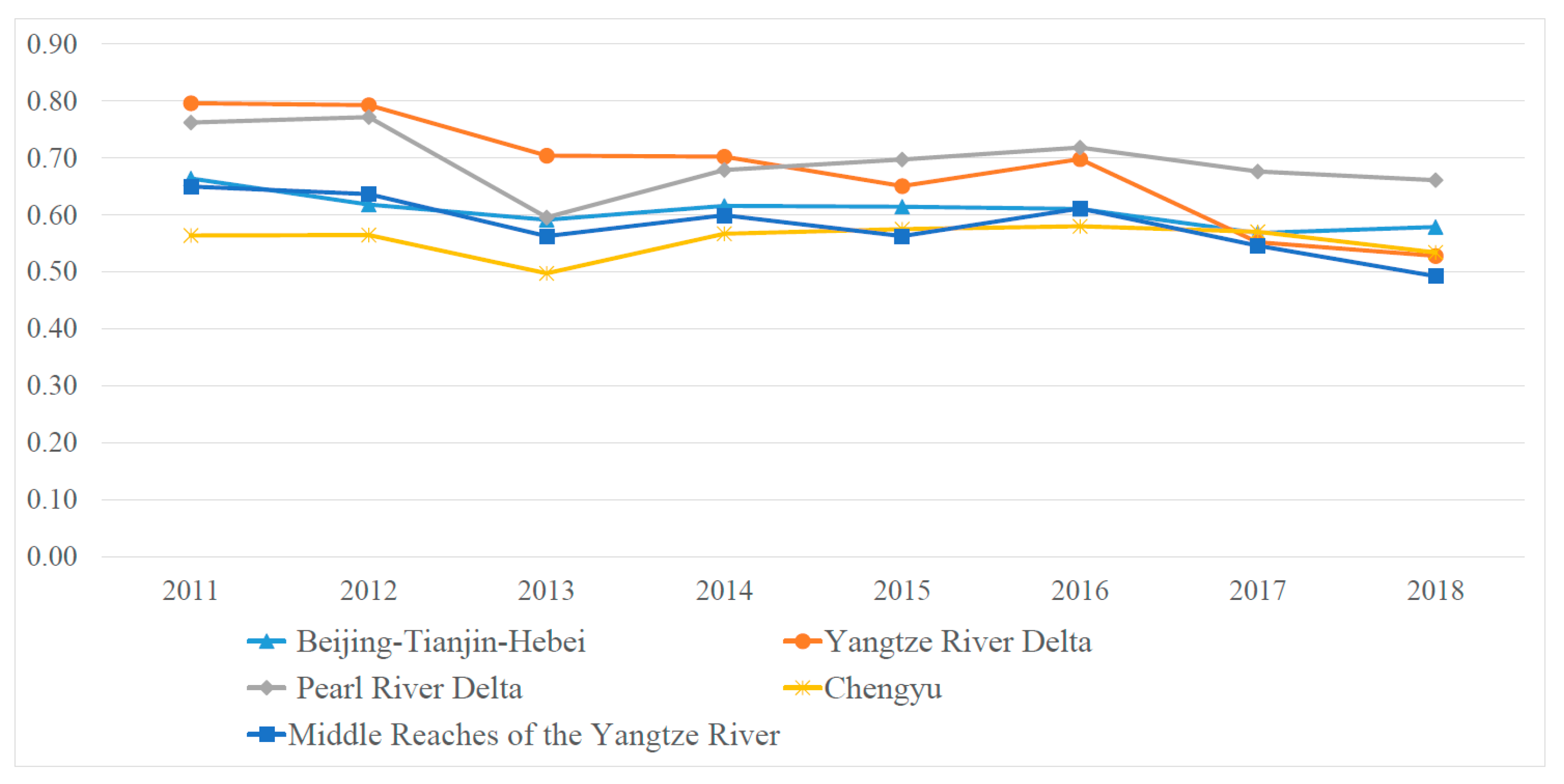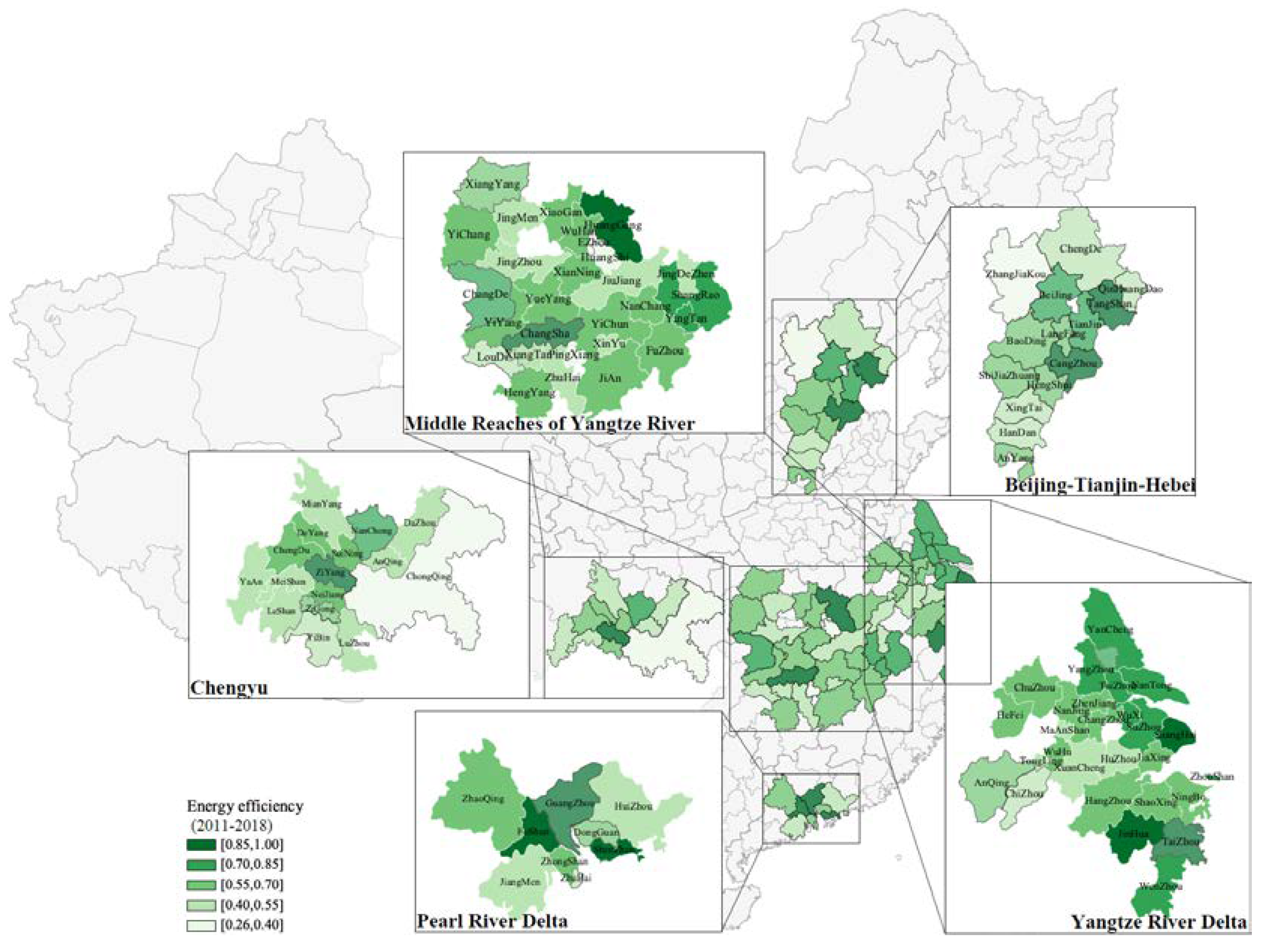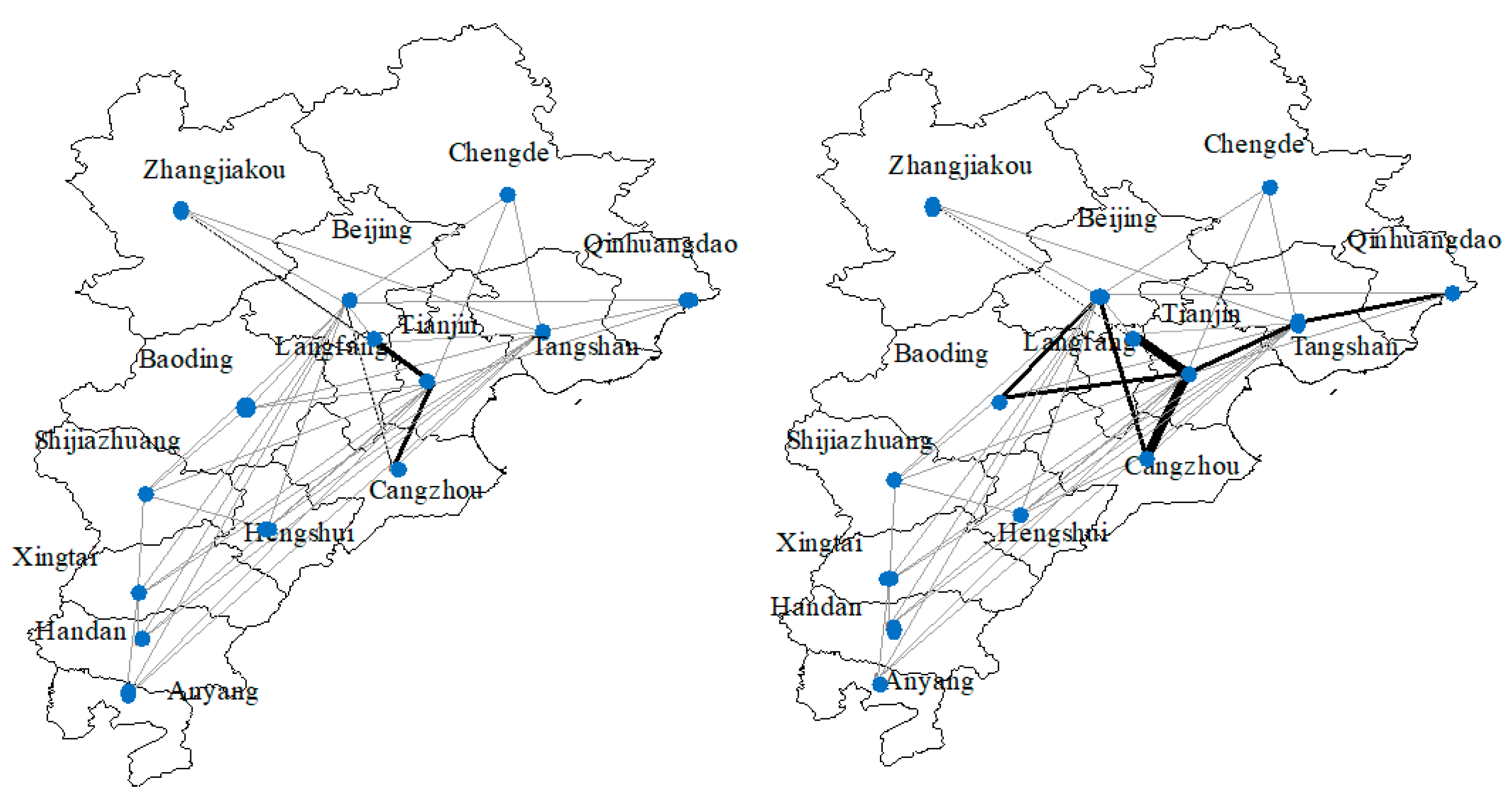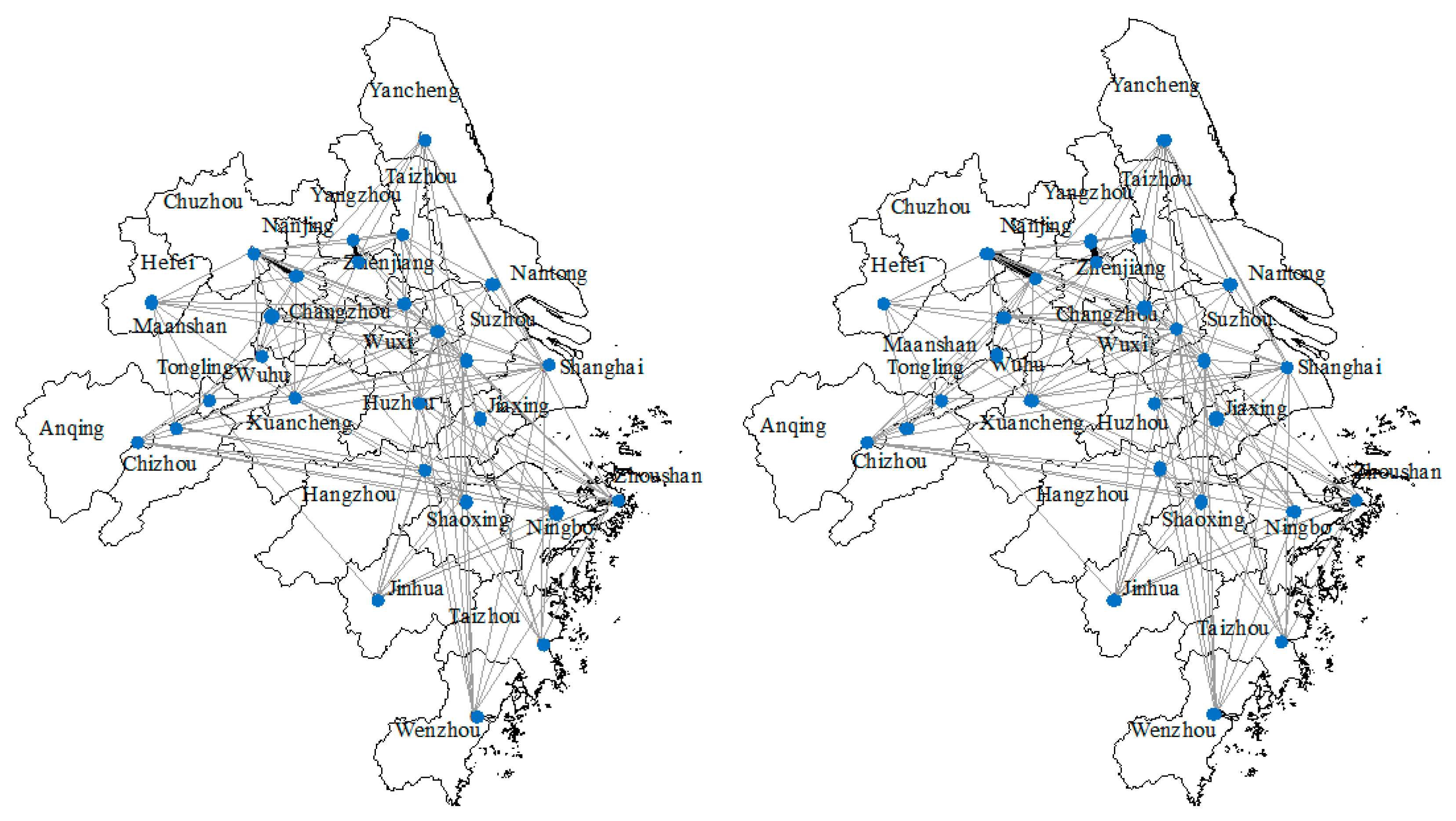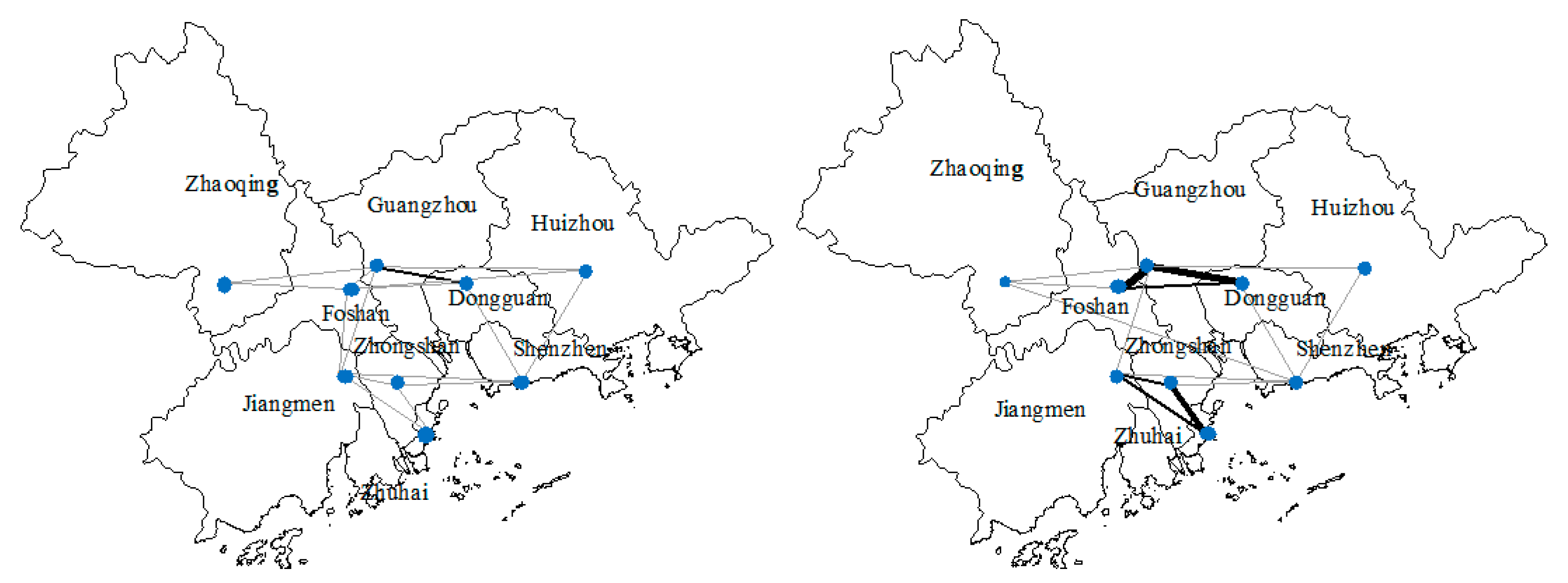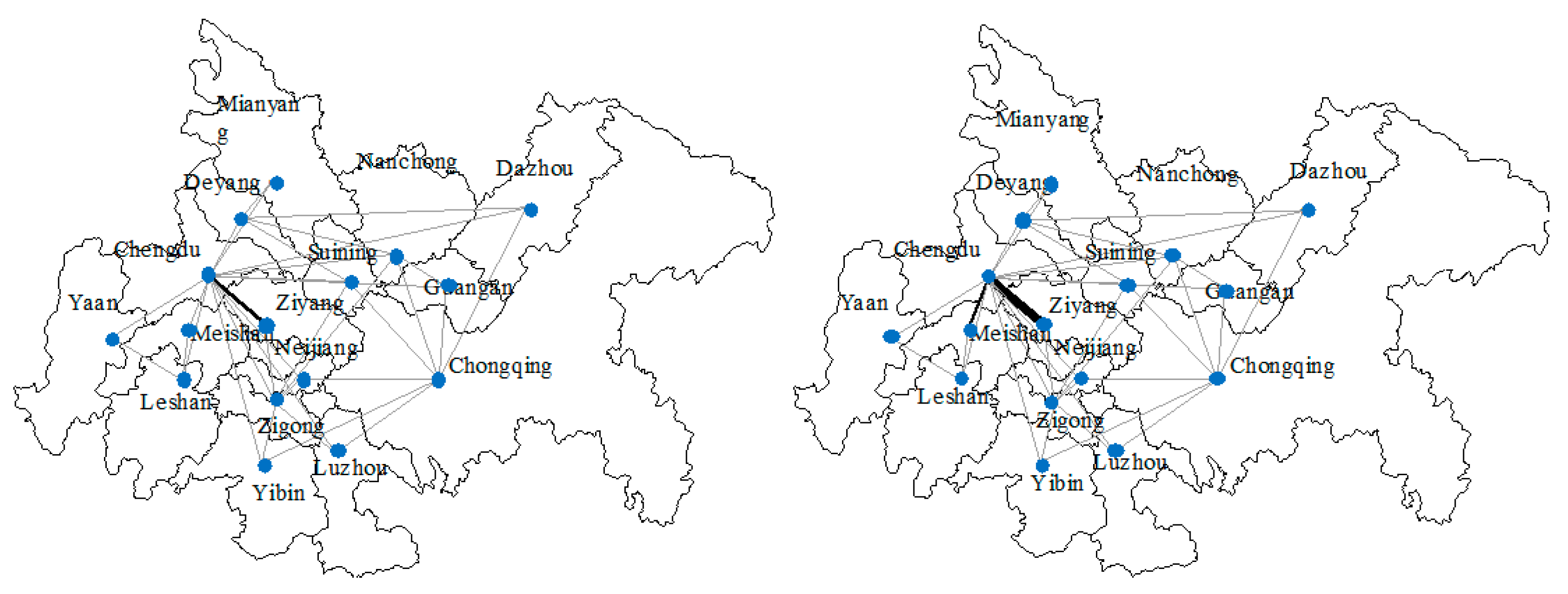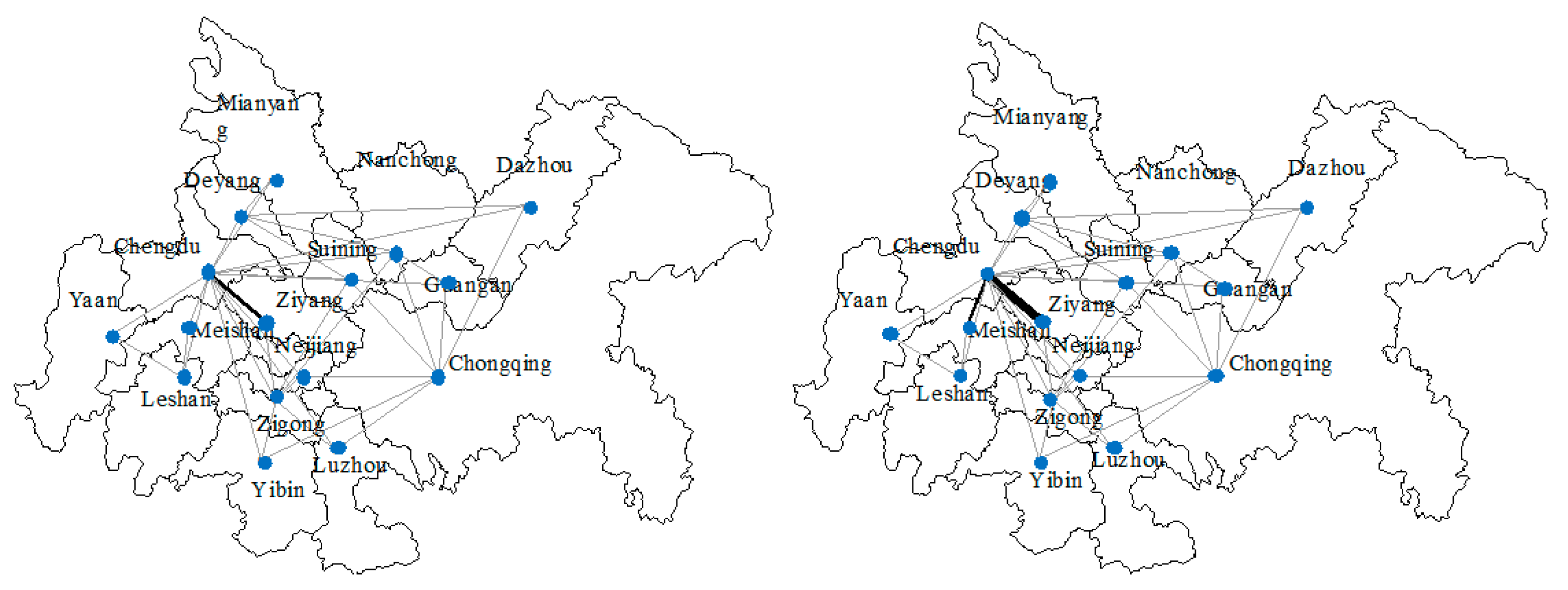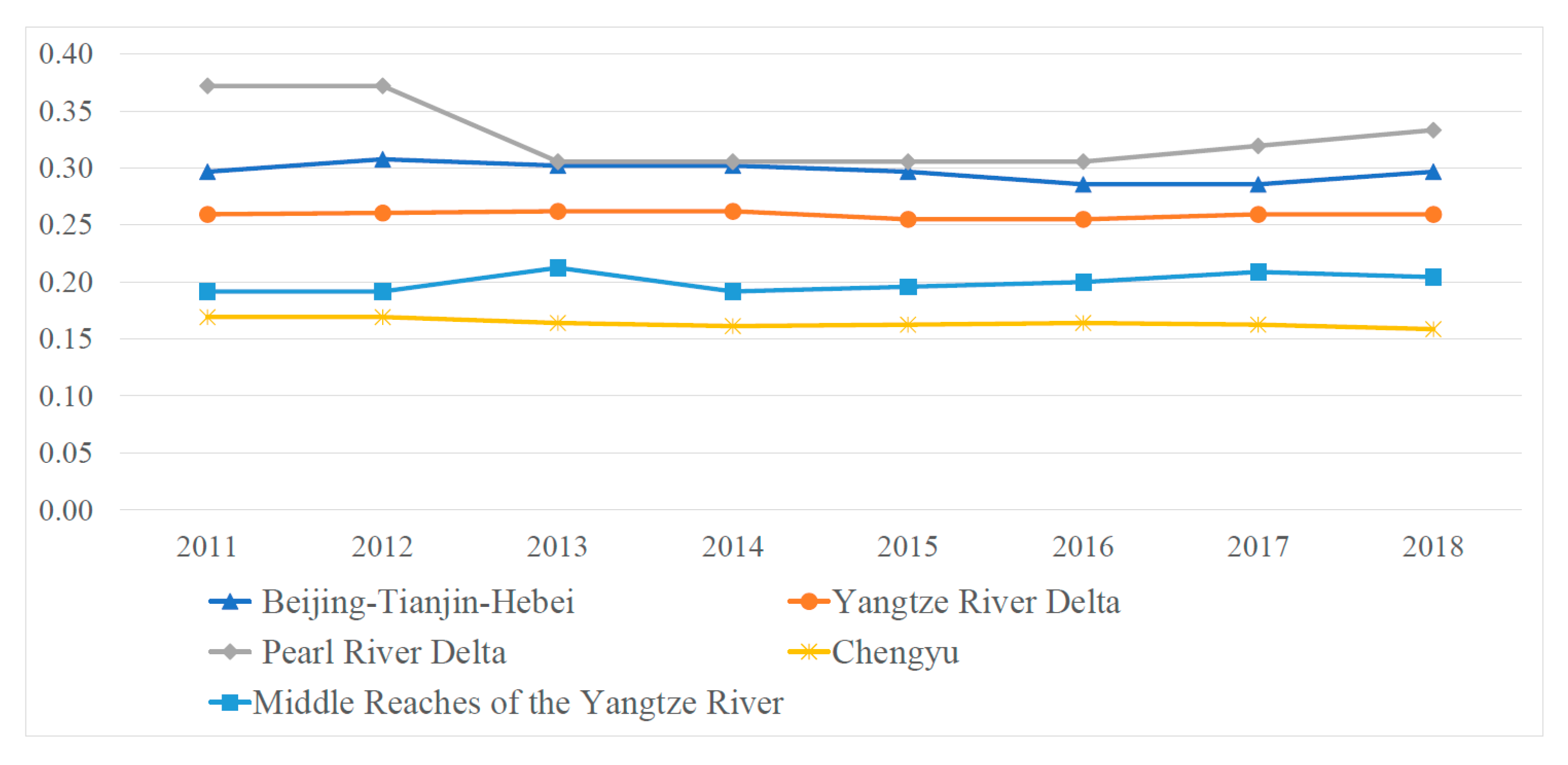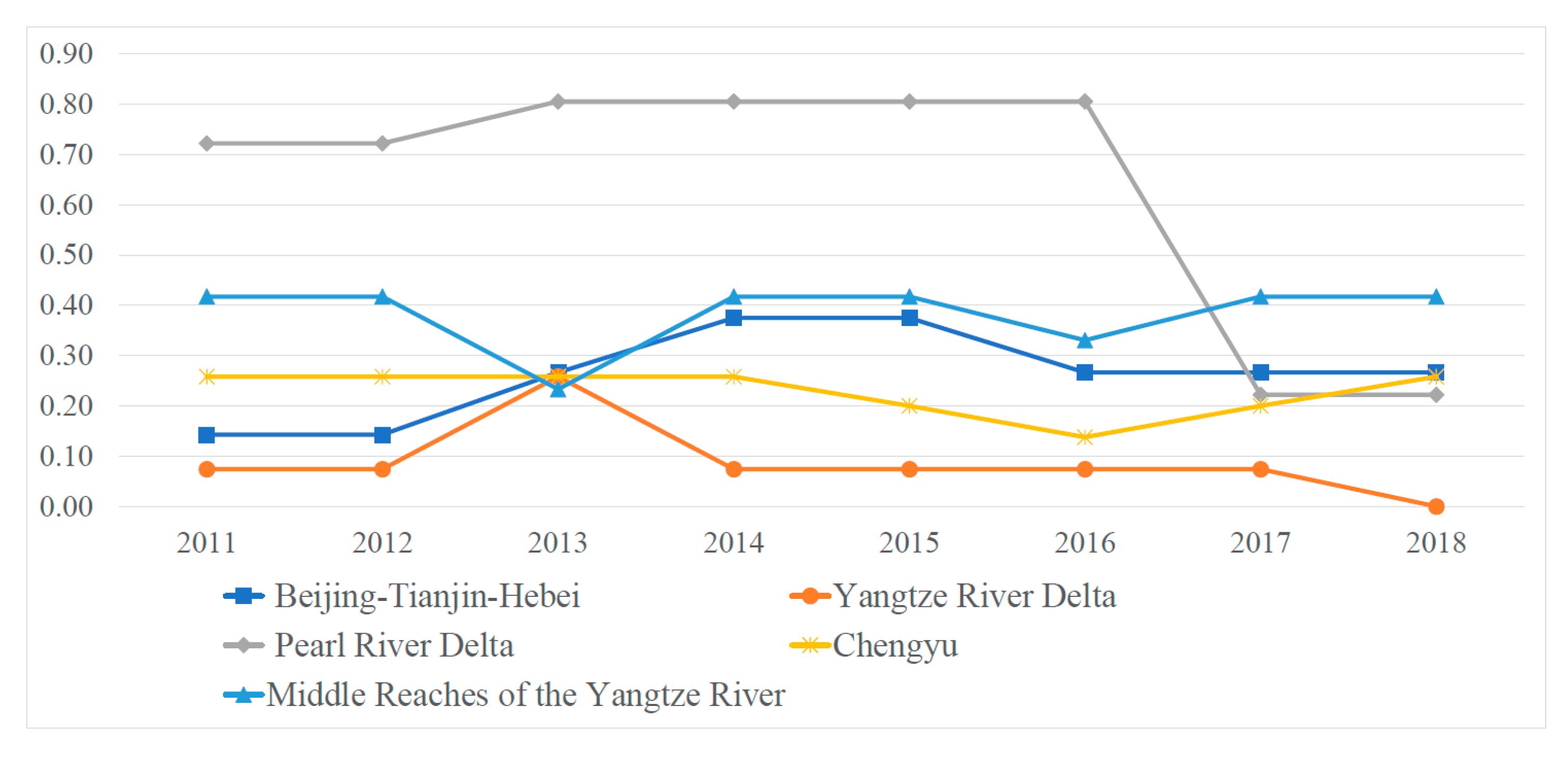1. Introduction
With economic development and intensive industrialization, humans have experienced a process of rapid urbanization during the past decades. Compared with only one-third of urban population in 1950, the world may roughly reverse the rural-urban population distribution by 2050 and about 70% of population will be settled in urban areas [
1]. The positive effect of the sprawling of urban landscapes has been evidenced to be capable of increasing economic efficiency, such as sharping economic growth, rising incomes and increasing productivity [
2]. Therefore, urban agglomeration, as an advanced spatial expressional form of integrated cities, can be the major engine of the urbanization for prosperous economic growth [
3], and has encouraged widespread interests among the urban studies and geography communities [
4]. Nevertheless, the development of urban agglomeration confronts challenges, especially on global climate change. Responsible for more than 70% of greenhouse gas emissions [
5] and 67–76% of global energy use [
6], urban areas have become the main battlefield in the fight against environmental and climate change. The process of urban agglomeration is proven to be able to alleviate greenhouse gas emissions [
6]; however, a significant gap in achieving net zero emissions by the middle of the century still exists [
7], and urban resilience for sustainable development is increasing [
8]. With the further expansion of urban agglomerations, extra urban infrastructure and more energy consumption are inevitably required, which are major contributors to greenhouse gas emissions. How global economies can balance the development of urban agglomeration and the commitment of the greenhouse gas emissions is a sophisticated issue and should be thoroughly investigated.
In the past years, to meet climate targets, international scholars and organizations have reached a consensus on the matter that energy efficiency is the first fuel, and its improvement progress should be accelerated. In response, great efforts at various levels in academic communities have been made to evaluate energy efficiency, analyze the corresponding influencing factors, discuss the relationship between energy efficiency and economic growth and the spatial effects, etc. With respect to recent energy efficiency evaluation, Wang et al. [
9] evaluated China’s regional energy efficiency performance by using the super efficiency data envelopment analysis and discussed regional disparity. During the past ten years, China’s regional energy efficiency is at a relatively low level, and the energy efficiency in the most developed region shows signs of downward trend. Li et al. [
10] used a similar model to study the industrial total factor energy efficiency and concluded that there is still room for the improvement of energy efficiency in the industrial sector. Zhang et al. [
11] considered the heterogenous impact on energy efficiency and conducted an empirical study on urban energy efficiency performance by combining the stochastic frontier analysis and the mean variance classification approach. They found that central cities with steady and relatively high energy efficiency can have significant impact on the energy efficiency improvement of their dependencies. Aldieri et al. [
12] investigated energy efficiency for both developed and developing countries through a joint analysis of innovation, resilience, and adaptation via the conventional frontier model. In addition to the development of the frontier methods for the evaluation of energy efficiency, multicriteria decision-making methods are also explored in this field, see Bai et al. [
13]. Another example is that a stochastic multicriteria acceptability analysis combining the preferences among energy trilemma was employed to measure national energy performance, see Song et al. [
14]. In addition to the macro perspective, scholars also discuss the efficiency improvement of energy utilization from a micro technical perspective. For example, the contribution of energy-saving technologies in improving energy efficiency is valued by [
15,
16,
17,
18]. The promotion of EVs in the transportation sector provides a powerful way to improve overall energy efficiency.
Notably, the early energy efficiency evaluation studies mainly concentrated on how to maximize the positive effect of energy consumption on economic growth by adopting the single-factor energy efficiency index. However, this index takes energy consumption as the only input and fails to consider the possible substitution effect among different inputs such as energy, capital, or labor [
19,
20]. The single factor energy efficiency index ignores the undesired output in the production process [
21]. Hence, Hu and Wang [
22] first introduced the index of the total factor energy efficiency based on the data envelopment analysis by considering multiple input factors. Compared with the single factor energy efficiency index, the new index was more consistent with the real production process. Until now, the total factor energy efficiency has been a standard framework in assessing energy efficiency at different levels, e.g., [
23,
24,
25,
26,
27,
28,
29].
To investigate how and what factors can influence the improvement of energy efficiency, many in-depth and detailed studies have been conducted. Meyer [
30] reported the effectiveness of market forces to promote energy efficiency. Higher marketization can force market players to continuously accelerate the progress of energy efficiency with production optimization. The study by Birol and Keppler [
31] emphasizes that the price of energy and new technologies are two important options to influence the changes in energy efficiency. The corresponding policies for these two options are suggested to be promoted simultaneously, rather than separately. The price factor is also proved by Steinbuks and Neuhoff [
32] with an econometric analysis on five manufacturing industries. Sun et al.’s [
33] research shows that the scale efficiency is the major contributor to the achievement of overall energy efficiency for resource-intensive cities, and a significant positive relationship exists between the urban population and urban energy efficiency. Recently, Liu et al. [
34] provided some evidence to prove per capita GDP, industrial and transport structure, and fuel price all have a positive impact on the energy efficiency of the transport sector by integrating the Tobit censored model and the truncated model. In addition to these four factors, Liu and Lin [
35] also confirmed that environmental protection can improve energy efficiency effectively. Besides, Li et al.’s [
10] empirical study further is evidence that environmental regulation nonlinearly affects industrial energy efficiency with a U-shaped relationship, which may indicate that strong environmental regulation should be implemented for the improvement of energy efficiency in industries. From a spatial perspective, Cheng et al. [
36] stated that different regions have significant differences of energy efficiency through the conditional convergence test. The studies conducted by Bai et al. [
37] in the transportation industry supports this conclusion, and Zhang et al. [
11] further found that the same influencing factors can have distinguished effects, especially considering the spatial and temporal dimensions. Du et al. [
38] pioneered the discussion of the spatial impacts of urban agglomeration on urban energy efficiency based on a mono-index and panel data in China.
It is plausible to suppose that the spatial factors may significantly impact on the improvement of energy efficiency. Energy efficiency has a spatial spillover effect with technology diffusion efficiency in essence [
39]. Regional energy efficiency can generate spatial spillover through an imitation and transmission mechanism [
6,
40,
41]. Therefore, the promotion of energy efficiency may consider the urban area’s own use efficiency and others’ spillover effects simultaneously. However, as we noticed, most of the previous studies used “attribute data” to investigate the spatial differentiation of the energy efficiency. Peng et al. [
42] criticized that “attribute data”-based studies can fail to reveal the structural characteristics of the spatial correlation. Structural characteristics often determine the performance of the “attribute data” and has more analytical value than “attribute data” [
39]. In addition, traditional multiple linear regression and spatial econometric methods may limit the spatial correlation to the adjacent areas in geography [
42]. Due to the improvement of infrastructure construction and the guidance of regional coordinated development policies, the production factors can exchange in a large spatial range. Traditional measurement methods may not thoroughly grasp the spatial structural correlation of energy efficiency among regions.
Hence, the network, which can contain multiple subjects and characterize structural features, has become a new method to study spatial relationships for improving the efficiency of policy implementation. For example, Bai et al. [
37] discussed the spatial properties that provincial carbon emissions in the transportation section show in the form of the network structure. He et al. [
43] empirically analyzed the network characteristics of carbon emissions in the electricity sector by integrating the social network analysis and gravity model and concluded China’s electricity sector shares a relatively stable overall network structure and are connected with each other closely. By an integrated analysis of network-oriented metrics, Gao et al. [
44] investigated the embodied energy flow in a developing country under the foundation of handling the supply-demand security and climate change. Similarly, Lv et al. [
45] investigated the embodied carbon transfer by joint analysis of multiregional input-output and social network analysis methods. Nevertheless, few studies are concerned about the spatial network structure of energy efficiency, especially in the areas of urban agglomeration. To the best of our knowledge, only Peng et al. [
42] examined and demonstrated the spatial network structure and the corresponding characteristics of energy eco-efficiency in China’s Jiangsu Province.
We address the gap by introducing the social network analysis method into the investigation of energy efficiency’s spatial structure characteristics in the China’s major urban agglomeration areas, i.e., Beijing-Tianjin-Hebei, the Yangtze River Delta and Pearl River Delta, Middle Reaches of the Yangtze River and Chengyu urban agglomerations. Currently, urban agglomeration is the major engine of the urbanization for supporting economic growth in China [
3], emphasized in the latest Five-Year Plan of China for further coordinated regional development. Relatively, Beijing-Tianjin-Hebei, the Yangtze River Delta and Pearl River Delta are characterized by the fastest increase in population, and are marked the most urbanized and highly economic development in China. While the Middle Reaches of the Yangtze River and Chengyu urban agglomerations, as the emerging centers of the central and western regions, are also experiencing a rapid speed of development. In 2018, these major urban agglomerations accounted for 40% of the country’s total population and 53.7% of the country’s total GDP. As the largest developing country, China has committed to reach peak emissions before 2030 and become carbon neutral before 2060. In carbon neutrality, the prosperous development of urban agglomerations inevitably faces huge pressures. This study focuses on the spatial structure relationship of energy efficiency in the national urban agglomerations through constructing the association network of the urban total factor energy efficiency. Then the structural association relationship of the regional energy efficiency and the role of different cities in the corresponding energy efficiency network can be comprehensively investigated. We hope the empirical study can break the limits of the geographical location in the energy efficiency research communities and provide insights in balancing the development of urban agglomeration and the commitment of the carbon emissions. Moreover, the policy implications drawn from the investigation of the spatial interactive structure of cities in urban agglomeration areas may be more targeted to optimize the spatial structure among cities, and jointly improve the connected urban energy efficiency.
In general, the main contributions of our study are as follows. Firstly, we explore the possibility of employing a social network analysis in the investigation of energy efficiency’s spatial structure characteristics. The proposed framework by integrating the total factor energy efficiency model and social network analysis can be used to study the spatial differentiation of energy efficiency using structural data, comparatively. Secondly, our empirical study was conducted on China’s representative urban agglomeration areas. The findings can have an important impact on policy implications, especially to those spatial connected cities.
The remainder of this paper is organized as follows.
Section 2 introduces the models employed to estimate the urban energy efficiency and to construct the corresponding spatial network structure of urban energy efficiency. A panel dataset is also introduced in this section. Based on the introduced models and dataset,
Section 3 implements the empirical study and discusses the results.
Section 4 summarizes this paper and proposes some suggestions. The symbols we introduced are listed in Nomenclature.

